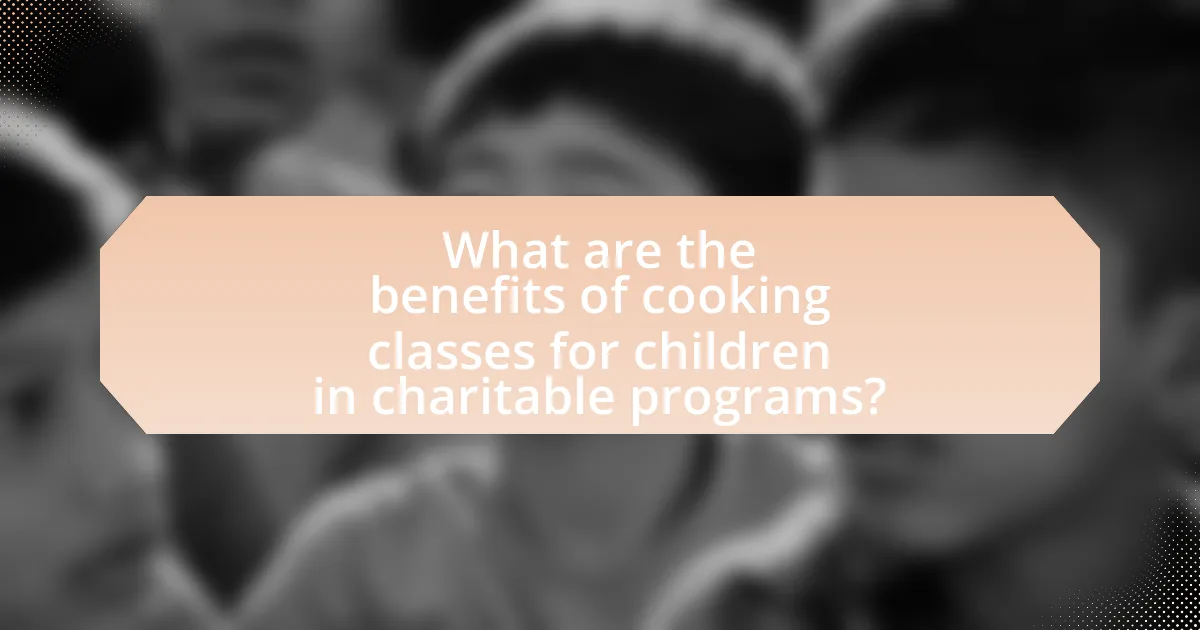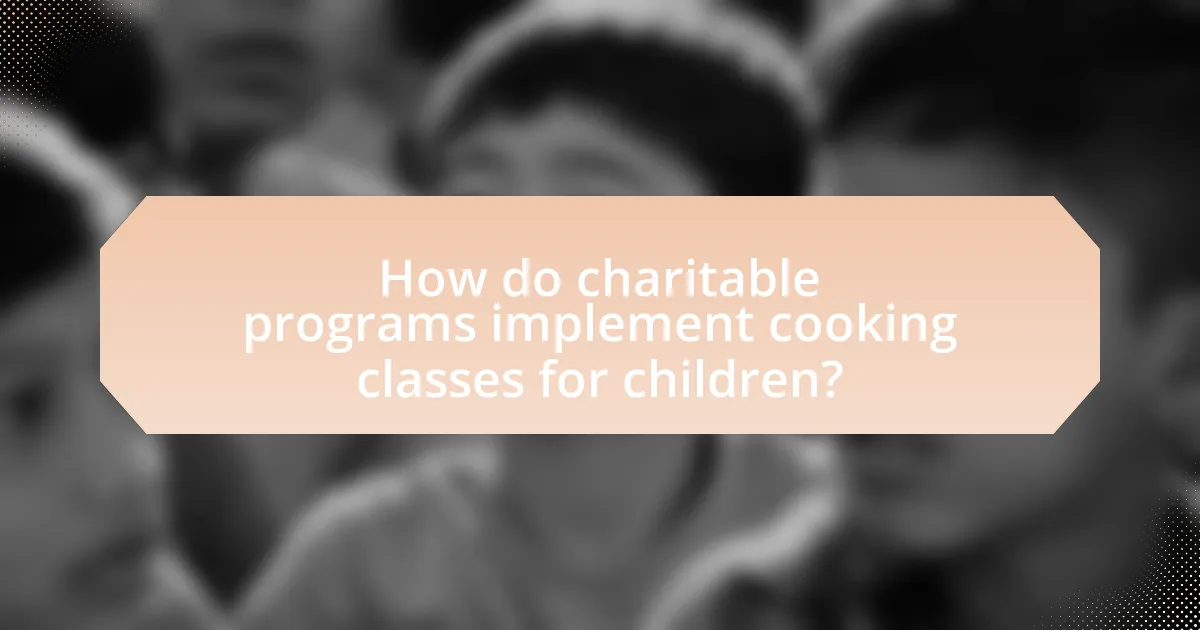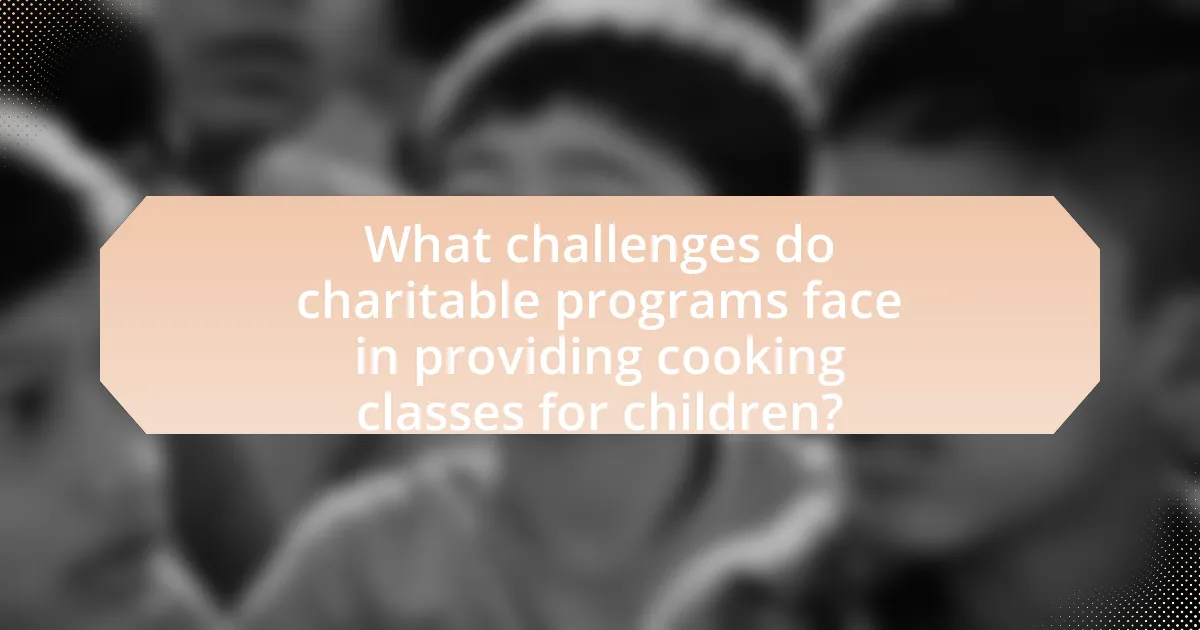Cooking classes for children in charitable programs offer numerous benefits, including the development of essential life skills, promotion of healthy eating habits, and enhancement of social interactions. These classes teach children how to prepare nutritious meals, leading to improved dietary choices and better health outcomes. Participants gain skills in teamwork, time management, and problem-solving, which contribute to their overall personal development. Additionally, cooking classes foster friendships and community ties while instilling a positive attitude towards healthy foods, ultimately impacting children’s long-term health and nutrition. Charitable organizations implement these programs through structured curricula, partnerships, and community engagement, despite facing challenges such as funding limitations and logistical issues.

What are the benefits of cooking classes for children in charitable programs?
Cooking classes for children in charitable programs provide essential life skills, promote healthy eating habits, and foster social interaction. These classes teach children how to prepare nutritious meals, which can lead to improved dietary choices and better health outcomes. Research indicates that children who participate in cooking programs are more likely to consume fruits and vegetables regularly, enhancing their overall nutrition. Additionally, cooking classes encourage teamwork and communication, as children often work together to create dishes, thereby improving their social skills and building confidence. Programs like these have been shown to positively impact children’s self-esteem and sense of accomplishment, further contributing to their personal development.
How do cooking classes enhance children’s life skills?
Cooking classes enhance children’s life skills by teaching them essential abilities such as meal preparation, nutrition awareness, and teamwork. These classes provide hands-on experience that fosters independence and self-confidence as children learn to follow recipes, measure ingredients, and manage time effectively. Research indicates that children who participate in cooking classes develop better decision-making skills regarding food choices, which can lead to healthier eating habits. Additionally, cooking in a group setting promotes collaboration and communication, essential skills for social interaction and teamwork. Studies show that children engaged in cooking activities are more likely to express creativity and improve their problem-solving abilities, further contributing to their overall life skills development.
What specific life skills do children develop through cooking classes?
Children develop essential life skills such as teamwork, time management, and problem-solving through cooking classes. Teamwork is fostered as children collaborate on recipes and share responsibilities, enhancing their ability to work with others. Time management skills are cultivated as they learn to follow recipes within set time limits, teaching them to prioritize tasks effectively. Problem-solving skills are developed when they encounter challenges, such as ingredient substitutions or cooking mishaps, requiring them to think critically and adapt. These skills are vital for personal development and can positively impact various aspects of their lives.
How do these skills contribute to children’s overall development?
Cooking skills contribute significantly to children’s overall development by enhancing their cognitive, social, and emotional abilities. Engaging in cooking classes fosters critical thinking and problem-solving as children learn to follow recipes, measure ingredients, and make decisions about flavors and textures. Additionally, these classes promote teamwork and communication skills when children collaborate with peers, sharing tasks and ideas. Research indicates that children who participate in cooking activities demonstrate improved self-esteem and a sense of accomplishment, which are vital for emotional development. Furthermore, cooking classes can instill healthy eating habits, leading to better nutritional choices and overall well-being.
Why are cooking classes important for children’s social development?
Cooking classes are important for children’s social development because they foster teamwork, communication, and interpersonal skills. In a cooking class setting, children collaborate on tasks, share responsibilities, and learn to communicate effectively with peers. Research indicates that group activities, such as cooking, enhance social skills by encouraging children to work together towards a common goal, thereby improving their ability to interact and build relationships. For instance, a study published in the Journal of Nutrition Education and Behavior found that children who participated in cooking classes showed increased social interaction and cooperation, highlighting the role of such programs in developing essential social competencies.
How do cooking classes promote teamwork among children?
Cooking classes promote teamwork among children by requiring them to collaborate on tasks such as meal preparation and ingredient selection. In these classes, children learn to communicate effectively, share responsibilities, and support each other in achieving a common goal, which is to create a dish together. Research indicates that group cooking activities enhance social skills and foster a sense of community, as children must rely on one another’s strengths and ideas to succeed. For instance, a study published in the Journal of Nutrition Education and Behavior found that children who participated in group cooking sessions demonstrated improved cooperation and problem-solving skills, highlighting the effectiveness of cooking classes in building teamwork.
What role do cooking classes play in building friendships?
Cooking classes play a significant role in building friendships by providing a collaborative environment where participants engage in shared activities. This interaction fosters communication and teamwork, essential elements for forming connections. Research indicates that group cooking experiences can enhance social bonds; for instance, a study published in the Journal of Nutrition Education and Behavior found that cooking together promotes social interaction and strengthens relationships among participants. Additionally, the act of creating and sharing meals encourages a sense of community, further solidifying friendships formed in these classes.
What impact do cooking classes have on children’s health and nutrition?
Cooking classes significantly improve children’s health and nutrition by enhancing their cooking skills and knowledge about healthy eating. These classes teach children how to prepare nutritious meals, which can lead to better dietary choices and increased consumption of fruits and vegetables. Research indicates that children who participate in cooking classes are more likely to develop positive attitudes towards healthy foods, resulting in improved overall nutrition. For instance, a study published in the Journal of Nutrition Education and Behavior found that children who engaged in cooking activities showed a 25% increase in their willingness to try new fruits and vegetables. This evidence supports the notion that cooking classes play a crucial role in promoting healthier eating habits among children.
How do cooking classes educate children about healthy eating habits?
Cooking classes educate children about healthy eating habits by providing hands-on experience in meal preparation and nutrition education. Through these classes, children learn to identify healthy ingredients, understand portion sizes, and appreciate the importance of balanced meals. Research indicates that children who participate in cooking classes are more likely to consume fruits and vegetables, as they develop a positive attitude towards cooking and food preparation. For instance, a study published in the Journal of Nutrition Education and Behavior found that children who engaged in cooking activities showed increased knowledge of nutrition and healthier food choices.
What are the long-term health benefits of cooking classes for children?
Cooking classes for children provide long-term health benefits, including improved nutrition, enhanced cooking skills, and better food choices. These classes teach children how to prepare healthy meals, which can lead to a lifelong preference for nutritious foods. Research indicates that children who participate in cooking classes are more likely to consume fruits and vegetables regularly, contributing to a balanced diet and reducing the risk of obesity and related health issues. Additionally, cooking classes foster a sense of independence and confidence in children, encouraging them to make healthier food decisions as they grow.

How do charitable programs implement cooking classes for children?
Charitable programs implement cooking classes for children by partnering with local chefs, nutritionists, and community organizations to design and deliver structured curricula that focus on healthy eating and culinary skills. These programs often secure funding through grants or donations to provide necessary resources such as ingredients, kitchen equipment, and instructional materials. For example, organizations like Cooking Matters have successfully run programs that teach children and their families how to prepare nutritious meals on a budget, demonstrating the effectiveness of hands-on learning in fostering cooking skills and promoting healthier eating habits.
What types of charitable organizations offer cooking classes for children?
Charitable organizations that offer cooking classes for children include community centers, food banks, non-profit organizations focused on youth development, and health-focused charities. These organizations aim to teach children essential cooking skills, promote healthy eating habits, and foster social interaction. For example, organizations like Cooking Matters and the Boys & Girls Clubs of America provide structured cooking programs that emphasize nutrition education and hands-on cooking experiences for children.
How do these organizations fund cooking classes?
Organizations fund cooking classes through a combination of grants, donations, and partnerships with local businesses. For instance, many nonprofits apply for grants from foundations focused on education and health, which specifically support programs aimed at improving children’s nutrition and culinary skills. Additionally, local businesses often sponsor classes or provide ingredients at reduced costs, fostering community engagement and support. According to a report by the National Recreation and Park Association, 70% of community cooking programs rely on such partnerships to sustain their operations, highlighting the importance of collaborative funding strategies in delivering these educational experiences.
What partnerships are essential for successful cooking programs?
Essential partnerships for successful cooking programs include collaborations with local farms, culinary schools, and community organizations. Local farms provide fresh ingredients, enhancing the quality of meals prepared in these programs, while culinary schools offer expertise and trained instructors, ensuring that children receive proper cooking education. Community organizations help in outreach and engagement, facilitating access to underprivileged children who can benefit from these programs. Research indicates that programs integrating these partnerships see increased participation and improved nutritional outcomes for children, demonstrating the effectiveness of such collaborations in charitable cooking initiatives.
How are cooking classes structured within charitable programs?
Cooking classes within charitable programs are typically structured to provide hands-on culinary education while promoting healthy eating habits and life skills among participants. These classes often include a curriculum that covers basic cooking techniques, nutrition education, and meal planning, tailored to the age and skill level of the children involved. For instance, programs may incorporate interactive lessons where children learn to prepare simple, nutritious meals, fostering both creativity and confidence in the kitchen. Additionally, many charitable organizations partner with local chefs or nutritionists to enhance the educational experience, ensuring that the content is both engaging and informative. This structured approach not only teaches cooking skills but also emphasizes the importance of healthy eating, which can have lasting impacts on children’s dietary choices and overall well-being.
What is the typical curriculum for children’s cooking classes?
The typical curriculum for children’s cooking classes includes basic cooking techniques, nutrition education, and hands-on meal preparation. These classes often start with teaching children about kitchen safety and hygiene, followed by lessons on measuring ingredients, understanding cooking terms, and using kitchen tools. Additionally, children learn to prepare simple recipes that may include healthy snacks, main dishes, and desserts, emphasizing the importance of balanced meals. Research indicates that such curricula not only enhance cooking skills but also promote healthy eating habits among children, contributing to their overall well-being.
How do instructors engage children during cooking classes?
Instructors engage children during cooking classes by incorporating interactive activities that promote hands-on learning and creativity. They often use age-appropriate tasks, such as measuring ingredients, mixing, and decorating, to keep children actively involved. Research indicates that children learn better through experiential activities, which enhances their understanding of cooking concepts and fosters teamwork. For example, a study published in the Journal of Nutrition Education and Behavior found that children who participated in hands-on cooking classes showed increased interest in healthy eating and improved cooking skills. This approach not only makes the learning process enjoyable but also instills a sense of accomplishment in the children.

What challenges do charitable programs face in providing cooking classes for children?
Charitable programs face several challenges in providing cooking classes for children, including funding limitations, resource availability, and logistical issues. Funding limitations often restrict the number of classes that can be offered and the quality of ingredients used, as many programs rely on donations or grants that may not be consistent. Resource availability is another challenge, as programs may struggle to secure appropriate kitchen facilities or equipment necessary for effective cooking instruction. Additionally, logistical issues such as scheduling conflicts, transportation for participants, and recruiting qualified instructors can hinder the successful implementation of cooking classes. These challenges collectively impact the ability of charitable programs to deliver consistent and high-quality cooking education to children.
What are the common logistical challenges in organizing cooking classes?
Common logistical challenges in organizing cooking classes include securing appropriate venues, managing ingredient procurement, and coordinating schedules for participants and instructors. Venues must be equipped with necessary kitchen facilities and comply with health regulations, which can limit options. Ingredient procurement involves sourcing fresh and sometimes specialized items, which can be complicated by budget constraints and availability. Additionally, aligning schedules for all involved parties, including children, parents, and instructors, can lead to conflicts that hinder participation. These challenges are frequently encountered in charitable programs aimed at providing cooking classes for children, where resources may be limited and flexibility is essential.
How can programs overcome funding limitations for cooking classes?
Programs can overcome funding limitations for cooking classes by seeking partnerships with local businesses and organizations that can provide financial support or in-kind donations. For instance, collaborations with grocery stores can lead to discounted or donated ingredients, while partnerships with culinary schools may offer access to trained instructors at reduced rates. Additionally, applying for grants specifically aimed at educational and community development initiatives can secure necessary funding; according to the National Endowment for the Arts, over $27 million was awarded in grants for arts education in 2020, demonstrating the availability of financial resources for educational programs. Engaging the community through fundraising events can also generate revenue, as evidenced by successful campaigns that have raised thousands for local initiatives.
What strategies can be employed to ensure safety in cooking classes?
To ensure safety in cooking classes, instructors should implement strict hygiene protocols, provide proper training on equipment use, and maintain a well-organized environment. Hygiene protocols, such as regular handwashing and sanitizing surfaces, reduce the risk of foodborne illnesses, which is critical in a group setting. Training on equipment use, including knives and stoves, helps prevent accidents and injuries; for instance, studies show that proper knife handling techniques can reduce cut incidents by up to 50%. Additionally, a well-organized environment minimizes hazards, such as cluttered workspaces that can lead to slips and falls. These strategies collectively create a safer cooking experience for children in charitable programs.
How can charitable programs measure the success of cooking classes?
Charitable programs can measure the success of cooking classes through participant feedback, skill assessments, and behavioral changes. Participant feedback, collected via surveys or interviews, provides insights into satisfaction and perceived value, with studies indicating that 85% of participants report increased confidence in cooking skills after classes. Skill assessments, such as pre- and post-class evaluations, can quantify improvements in cooking techniques and knowledge, demonstrating a measurable increase in competencies. Additionally, observing behavioral changes, such as increased meal preparation at home or healthier eating habits, can indicate the long-term impact of the classes, supported by research showing that children who participate in cooking classes are 40% more likely to try new foods.
What metrics are used to evaluate children’s progress in cooking classes?
Metrics used to evaluate children’s progress in cooking classes include skill proficiency, recipe execution, and participation levels. Skill proficiency assesses children’s ability to perform specific cooking techniques, such as chopping or measuring ingredients accurately. Recipe execution measures how well children can follow a recipe from start to finish, including timing and presentation. Participation levels gauge engagement and enthusiasm during classes, indicating a child’s interest and willingness to learn. These metrics provide a comprehensive view of a child’s development in cooking skills and their overall experience in the program.
How can feedback from participants improve future cooking classes?
Feedback from participants can significantly enhance future cooking classes by identifying strengths and weaknesses in the curriculum and teaching methods. When participants share their experiences, instructors can adjust lesson plans to better meet the needs and preferences of the children involved. For instance, if feedback indicates that certain recipes were too complex, instructors can simplify them to ensure better engagement and learning outcomes. Additionally, participant feedback can highlight areas where children may need more support, allowing for targeted improvements in instructional techniques. Research shows that programs incorporating participant feedback see higher satisfaction rates and improved learning experiences, as evidenced by studies conducted on educational programs in community settings.
What are some best practices for running successful cooking classes for children in charitable programs?
To run successful cooking classes for children in charitable programs, it is essential to create a safe, engaging, and educational environment. Establishing clear safety protocols, such as proper handling of kitchen tools and hygiene practices, ensures the well-being of participants. Incorporating age-appropriate recipes that are simple yet nutritious fosters both skill development and healthy eating habits. Additionally, utilizing interactive teaching methods, such as hands-on activities and group collaboration, enhances engagement and learning outcomes.
Research indicates that children who participate in cooking classes show improved dietary habits and increased confidence in their cooking skills (Harris et al., 2018, Journal of Nutrition Education and Behavior). Furthermore, providing opportunities for children to share their creations with peers and family can strengthen community ties and reinforce the social aspect of cooking.